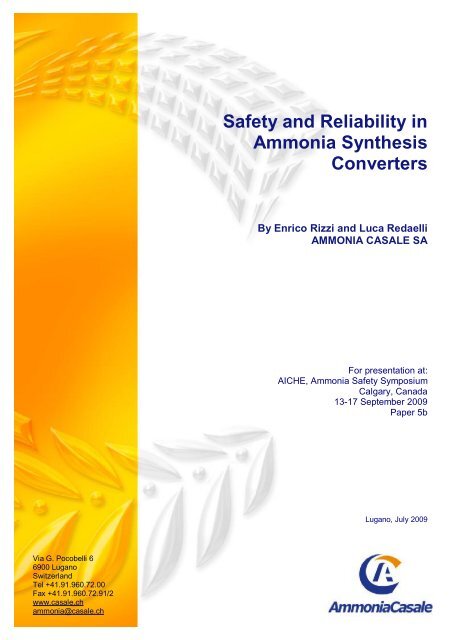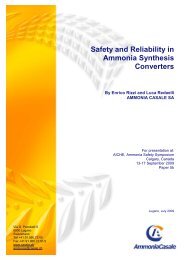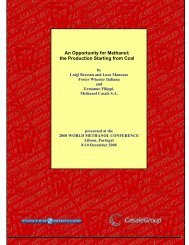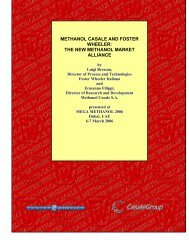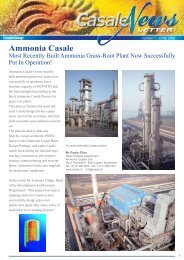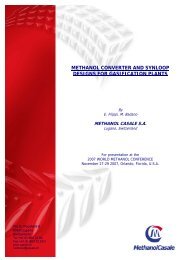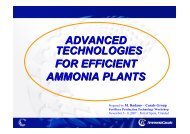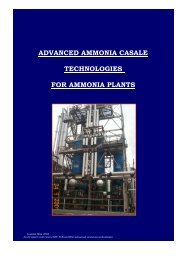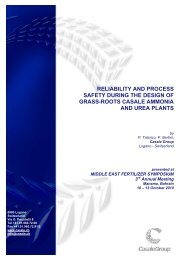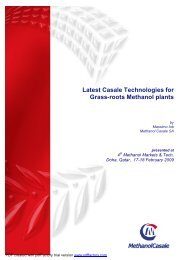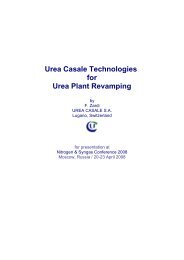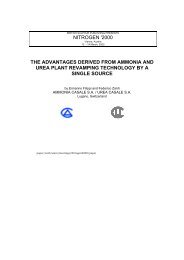Safety and Reliability in Ammonia Synthesis Converters
Safety and Reliability in Ammonia Synthesis Converters
Safety and Reliability in Ammonia Synthesis Converters
You also want an ePaper? Increase the reach of your titles
YUMPU automatically turns print PDFs into web optimized ePapers that Google loves.
Via G. Pocobelli 6<br />
6900 Lugano<br />
Switzerl<strong>and</strong><br />
Tel +41.91.960.72.00<br />
Fax +41.91.960.72.91/2<br />
www.casale.ch<br />
ammonia@casale.ch<br />
<strong>Safety</strong> <strong>and</strong> <strong>Reliability</strong> <strong>in</strong><br />
<strong>Ammonia</strong> <strong>Synthesis</strong><br />
<strong>Converters</strong><br />
By Enrico Rizzi <strong>and</strong> Luca Redaelli<br />
AMMONIA CASALE SA<br />
For presentation at:<br />
AICHE, <strong>Ammonia</strong> <strong>Safety</strong> Symposium<br />
Calgary, Canada<br />
13-17 September 2009<br />
Paper 5b<br />
Lugano, July 2009
<strong>Safety</strong> <strong>and</strong> <strong>Reliability</strong> <strong>in</strong><br />
<strong>Ammonia</strong> <strong>Synthesis</strong> <strong>Converters</strong><br />
<strong>Ammonia</strong> synthesis converters are key items <strong>in</strong> ammonia plants. Their reliability is essential, as a<br />
plant cannot run if the converter is down. S<strong>in</strong>ce their performance has a significant impact on<br />
the overall plant energy consumption, they also have to operate efficiently. In addition, the<br />
ammonia synthesis converter is the reactor with the longest run between catalyst changes, <strong>and</strong><br />
therefore, they must run for 10-15 years without the eventuality of repairs or <strong>in</strong>spections.<br />
These units have also an impact on the safety of plants, as they are subject to different<br />
metallurgical deterioration phenomena, <strong>and</strong>, as they have a quite complicated mechanical design<br />
with multiple catalyst beds. The catalyst replacements <strong>and</strong> <strong>in</strong>spections are difficult tasks also<br />
from a safety po<strong>in</strong>t of view. This paper presents these various aspects <strong>in</strong> detail, <strong>and</strong> the<br />
experience <strong>and</strong> solutions to problems achieved so far by <strong>Ammonia</strong> Casale S.A.<br />
Introduction<br />
A<br />
mmonia synthesis converters are key<br />
items <strong>in</strong> ammonia plants. Their<br />
reliability is essential, as a plant cannot<br />
run if the converter is down. In addition, the<br />
ammonia synthesis converter is the reactor with<br />
the longest run between catalyst changes, s<strong>in</strong>ce<br />
they must run for 10-15 years. <strong>Ammonia</strong><br />
catalyst, once reduced, should not come <strong>in</strong><br />
contact with oxygen s<strong>in</strong>ce is highly pyrophoric.<br />
Therefore converters should operate between<br />
Catalyst changes without repairs or <strong>in</strong>spections.<br />
To achieve this result without any impact on the<br />
safety <strong>and</strong> reliability of plants, several aspects<br />
have to be considered as converters are subject<br />
to different metallurgical deterioration<br />
phenomena, <strong>and</strong>, as they have a complicated<br />
mechanical design with multiple catalyst beds.<br />
Enrico Rizzi <strong>and</strong> Luca Redaelli<br />
<strong>Ammonia</strong> Casale S.A., Switzerl<strong>and</strong><br />
From a safety po<strong>in</strong>t of view, the catalyst<br />
replacements <strong>and</strong> <strong>in</strong>spections are critical as<br />
well.<br />
1. <strong>Ammonia</strong> <strong>Synthesis</strong> Environment <strong>and</strong><br />
Metallurgy<br />
Due to the aggressive environment created by<br />
the comb<strong>in</strong>ation of high pressure, high<br />
temperature <strong>and</strong> peculiar gas composition <strong>in</strong><br />
which the converter operates, the first aspect to<br />
be considered <strong>in</strong> the design of the <strong>Ammonia</strong><br />
synthesis converters, to ensure a high reliability,<br />
is the materials selection. This has to consider<br />
the conditions <strong>and</strong> the composition of the gas.<br />
The concurrence of Hydrogen related damages<br />
<strong>and</strong> Nitrid<strong>in</strong>g is typical of the <strong>Ammonia</strong><br />
synthesis loop, particularly of the ammonia<br />
converter, where the highest temperatures <strong>and</strong><br />
pressures are comb<strong>in</strong>ed with high content of<br />
hydrogen <strong>and</strong> ammonia.<br />
For presentation at: AIChE, <strong>Ammonia</strong> <strong>Safety</strong> Symposium, Calgary, Canada * 13-17 September 2009, Paper 5b<br />
3
1.1. Hydrogen Influence<br />
1.1.1. High Temperature Hydrogen<br />
Attack<br />
In hydrogen rich service environments, under<br />
certa<strong>in</strong> conditions of temperature <strong>and</strong> pressure,<br />
carbon <strong>and</strong> low alloy steels can suffer<br />
irreversible damage due to hydrogen attack. Its<br />
mechanism, detailed treated <strong>in</strong> International<br />
recognized st<strong>and</strong>ards such as API 941, has two<br />
detrimental effects, namely loss of mechanical<br />
strength due to loss of carbon <strong>and</strong> the formation<br />
of a network of fissures <strong>and</strong> cracks throughout<br />
the microstructure (Fig. 1). With on-go<strong>in</strong>g<br />
exposure, these micro fissures cont<strong>in</strong>ue to grow<br />
<strong>and</strong> consolidate <strong>in</strong>to macro-cracks <strong>and</strong>, if not<br />
detected, will eventually grow sufficiently to<br />
result <strong>in</strong> failure of the pressurised component.<br />
Fig. 1 - High Temperature Hydrogen<br />
Attack<br />
1.1.2. Hydrogen Debond<strong>in</strong>g<br />
Equipment <strong>in</strong>volv<strong>in</strong>g moderate to high<br />
temperatures <strong>and</strong> moderate to high hydrogen<br />
pressures, are commonly manufactured from<br />
low alloy (Cr-Mo) steels with an <strong>in</strong>ternal<br />
surface overlay of an austenitic material such as<br />
a 300 series sta<strong>in</strong>less steel or Inconel 600.<br />
The <strong>in</strong>tent of the overlay is believed to provide<br />
protection aga<strong>in</strong>st such degradation mechanisms<br />
as high temperature hydrogen attack <strong>and</strong><br />
nitrid<strong>in</strong>g.<br />
There have been numerous documented<br />
<strong>in</strong>stances where process equipment<br />
<strong>in</strong>corporat<strong>in</strong>g this ‘clad design’ has suffered<br />
from crack<strong>in</strong>g after be<strong>in</strong>g <strong>in</strong> service for a period<br />
of time. This crack<strong>in</strong>g, often referred to as<br />
debond<strong>in</strong>g, commonly occurs at the <strong>in</strong>terface of<br />
the austenitic weld overlay <strong>and</strong> the base metal.<br />
The mode of crack<strong>in</strong>g / debond<strong>in</strong>g is believed to<br />
be hydrogen-<strong>in</strong>duced with the hydrogen<br />
enter<strong>in</strong>g the wall of the pressure equipment<br />
dur<strong>in</strong>g normal operation <strong>and</strong> possibly also<br />
dur<strong>in</strong>g orig<strong>in</strong>al weld fabrication. Dur<strong>in</strong>g a<br />
cool<strong>in</strong>g down cycle (plant shutdown) hydrogen<br />
can become entrapped at the overlay-base metal<br />
<strong>in</strong>terface of pressure equipment, reach<strong>in</strong>g<br />
saturation levels at ambient conditions. The<br />
faster the rate of cool<strong>in</strong>g of the pressure<br />
equipment, the higher the likelihood of<br />
entrapped hydrogen caus<strong>in</strong>g debond<strong>in</strong>g.<br />
1.2. Nitrogen Influence<br />
1.2.1. Nitrid<strong>in</strong>g<br />
Above a certa<strong>in</strong> temperature, depend<strong>in</strong>g on the<br />
type of steel, ammonia reacts with iron to form a<br />
hard <strong>and</strong> brittle Fe-N <strong>in</strong>ter-metallic compound.<br />
This phenomenon is called Nitrid<strong>in</strong>g (Fig. 2).<br />
The nitrid<strong>in</strong>g rate depends on temperature <strong>and</strong><br />
on ammonia partial pressure.<br />
Nitrid<strong>in</strong>g develops on low alloy steels <strong>and</strong> on<br />
sta<strong>in</strong>less steels, however the latter at a much<br />
reduced rate compared with low alloy steels.<br />
For this reason <strong>in</strong> ammonia atmosphere, usually<br />
above 370-380°C, carbon steel <strong>and</strong> low alloy<br />
steels are not used <strong>in</strong> contact with fluid <strong>and</strong><br />
replaced with austenitic sta<strong>in</strong>less steel or even<br />
non ferrous alloy.<br />
In regions where sufficiently high stresses are<br />
applied, crack of the nitrided layer can start;<br />
after that, the apex of the crack nitrides,<br />
allow<strong>in</strong>g the crack grow<strong>in</strong>g faster <strong>and</strong> faster.<br />
For presentation at: AIChE, <strong>Ammonia</strong> <strong>Safety</strong> Symposium, Calgary, Canada * 13-17 September 2009, Paper 5b<br />
4
Fig. 2 - Example of Nitrid<strong>in</strong>g<br />
2. <strong>Safety</strong> - Casale Design for <strong>Ammonia</strong><br />
<strong>Synthesis</strong> Environment<br />
The solutions to the metallurgical problems<br />
described above are a suitable choice of<br />
materials <strong>and</strong> design of the equipment.<br />
S<strong>in</strong>ce the detrimental effects of the environment<br />
on the materials <strong>in</strong>creases by <strong>in</strong>creas<strong>in</strong>g the<br />
temperature the latter needs to be kept as low as<br />
possible. Casale philosophy consists <strong>in</strong> a<br />
suitable material selection <strong>and</strong> generally<br />
keep<strong>in</strong>g the materials at a lower temperature<br />
through a suitable thermal <strong>in</strong>sulation <strong>and</strong>/or gas<br />
flush. This concept allows <strong>in</strong>tr<strong>in</strong>sically<br />
<strong>in</strong>creas<strong>in</strong>g the safety of high-pressure parts <strong>and</strong><br />
is a fundamental start<strong>in</strong>g po<strong>in</strong>t for the revamp of<br />
exist<strong>in</strong>g equipment.<br />
2.1. Hydrogen Influence<br />
2.1.1. High pressure parts<br />
The pressure vessel usually has a much lower<br />
operat<strong>in</strong>g temperature than the <strong>in</strong>ternals, <strong>and</strong>,<br />
for economical reasons, ferritic materials such<br />
Carbon steel or Chrome-Moly steels are<br />
generally used, selected accord<strong>in</strong>g to the API<br />
941 st<strong>and</strong>ard.<br />
S<strong>in</strong>ce the ferritic components of hot pressure<br />
parts (typically outlet nozzle <strong>and</strong> start-up<br />
nozzle) suffer from nitrid<strong>in</strong>g, a designer can<br />
consider to weld overlay the parts with<br />
austenitic materials or high nickel alloys.<br />
However this solution does not protect aga<strong>in</strong>st<br />
Hydrogen debond<strong>in</strong>g. For this reason, Casale<br />
design considers to thermally <strong>in</strong>sulate the hot<br />
vessel regions rather than cladd<strong>in</strong>g them.<br />
The <strong>in</strong>sulation consists of an Inconel l<strong>in</strong>er filled<br />
with <strong>in</strong>sulat<strong>in</strong>g materials (e.g. ceramic fiber).<br />
The <strong>in</strong>sulation is easily accessible, easy to<br />
<strong>in</strong>spect <strong>and</strong> simply replaceable.<br />
In case of revamp, this k<strong>in</strong>d of <strong>in</strong>sulation can be<br />
fitted <strong>in</strong> exist<strong>in</strong>g pressure vessels without major<br />
modifications. This situation is the most critical,<br />
s<strong>in</strong>ce the base material sometimes is not suitable<br />
to the new conditions or the experience has<br />
demonstrated that it is not totally free from<br />
Hydrogen attack at the operat<strong>in</strong>g condition: this<br />
is the case of ½ Mo steel operat<strong>in</strong>g above the<br />
present respective alloy steel 'Nelson' curve.<br />
It is also important to avoid any weld on the<br />
exist<strong>in</strong>g pressure vessel <strong>in</strong> order not to<br />
additional affect the base material that may be<br />
damaged by Hydrogen or nitrid<strong>in</strong>g <strong>and</strong> to avoid<br />
the need of a new post weld heat treatment.<br />
High-pressure heterogeneous welds of hot parts<br />
which are critical due to thermal stresses<br />
comb<strong>in</strong>ed to hydrogen debond<strong>in</strong>g are avoided,<br />
replac<strong>in</strong>g them with special flanged connections<br />
2.1.3. Case History –Bottom Fitt<strong>in</strong>g<br />
Casale has experience of converters, designed<br />
by others, whose bottom fitt<strong>in</strong>g (outlet nozzle),<br />
<strong>in</strong> Low alloy steel with Inconel 600 weld<br />
overlay, suffered from cracks due to hydrogen<br />
debond<strong>in</strong>g. In one case, dur<strong>in</strong>g the revamp of<br />
the converter, Casale removed the cracks <strong>and</strong><br />
<strong>in</strong>stalled <strong>in</strong>sulation accord<strong>in</strong>g to the abovementioned<br />
design, solv<strong>in</strong>g permanently the<br />
problem (<strong>in</strong> service with s<strong>in</strong>ce 1995). The<br />
resistance of the bottom fitt<strong>in</strong>g after the cracks<br />
removal by gr<strong>in</strong>d<strong>in</strong>g had been checked by<br />
means of f<strong>in</strong>ite elements calculations (Fig. 3).<br />
For presentation at: AIChE, <strong>Ammonia</strong> <strong>Safety</strong> Symposium, Calgary, Canada * 13-17 September 2009, Paper 5b<br />
5
2.1.4. Case History – Hot Wall Pressure<br />
Vessel<br />
Hot wall vessels have no cold gas flush<strong>in</strong>g, so<br />
that they operate at the temperature <strong>and</strong> gas<br />
composition prevalent at the <strong>in</strong>let of each bed.<br />
This design, adopted for example by C.F.<br />
Braun, has proven to be susceptible to damage,<br />
as demonstrated <strong>in</strong> many plants, s<strong>in</strong>ce, after<br />
some years of operation the vessels show<br />
extensive damages due to the comb<strong>in</strong>ed effect<br />
of hydrogen attack <strong>and</strong> nitrid<strong>in</strong>g. Casale has<br />
revamped or replaced some of these converters.<br />
The revamp <strong>in</strong>troduced a fresh gas flush <strong>and</strong> a<br />
thermal barrier.<br />
3. Internals Ma<strong>in</strong>tenance<br />
While safe operation depends on the <strong>in</strong>tegrity of<br />
the high-pressure parts, enter<strong>in</strong>g the reactor<br />
dur<strong>in</strong>g shutdowns to perform work or<br />
Fig. 3 - Bottom Fitt<strong>in</strong>g Thermal Stress Analysis<br />
<strong>in</strong>spections presents a different set of hazard<br />
considerations. In fact the presence of ammonia<br />
or nitrogen purge to avoid catalyst oxidation<br />
represents poisonous conditions for the humans<br />
<strong>and</strong> the presence of hydrogen may <strong>in</strong>volve risk<br />
of explosions while work<strong>in</strong>g <strong>in</strong>side the<br />
converter.<br />
For this reason <strong>in</strong>ternals should be designed to<br />
be essentially ma<strong>in</strong>tenance free <strong>in</strong> between<br />
catalyst replacement.<br />
Moreover, these potentially dangerous<br />
conditions can be overcome or m<strong>in</strong>imized<br />
through an apposite design of the <strong>in</strong>ternals.<br />
3.1. <strong>Safety</strong> - New <strong>Converters</strong><br />
To limit the potentially dangerous access to the<br />
converter dur<strong>in</strong>g catalyst replacement <strong>and</strong><br />
ma<strong>in</strong>tenance, Casale has developed specific<br />
design features, which therefore <strong>in</strong>crease the<br />
safety of the converter.<br />
For presentation at: AIChE, <strong>Ammonia</strong> <strong>Safety</strong> Symposium, Calgary, Canada * 13-17 September 2009, Paper 5b<br />
6
3.1.1. Removable Baskets – Catalyst<br />
Drop Out<br />
The advantage of the well-known full open<strong>in</strong>g<br />
pressure vessel is easy access to the <strong>in</strong>ternals<br />
<strong>and</strong> the possibility to lift complete beds. These<br />
features should however be improved, so that<br />
<strong>in</strong>stallation or dismantl<strong>in</strong>g could be carried out<br />
without perform<strong>in</strong>g any weld<strong>in</strong>g or bolt<strong>in</strong>g<br />
<strong>in</strong>side the reactor. For this purpose Casale<br />
developed <strong>in</strong> the late 70s a basket design<br />
allow<strong>in</strong>g <strong>in</strong>stallation <strong>and</strong> removal from a full<br />
open<strong>in</strong>g pressure vessel without any mechanical<br />
work <strong>in</strong>side the reactor.<br />
This is possible thanks to patented design<br />
features such as the reverse bottom basket (Fig.<br />
4) where the edge of the basket bottom seals the<br />
<strong>in</strong>let of the bed aga<strong>in</strong>st the support r<strong>in</strong>g on the<br />
cartridge through a special gasket.<br />
The advantages of this design, apart from the<br />
higher catalyst volume available <strong>and</strong> the easier<br />
<strong>and</strong> faster catalyst replacement are evident <strong>in</strong><br />
terms of safety.<br />
In fact, it is possible to perform catalyst load<strong>in</strong>g<br />
outside the pressure vessel, without any life<br />
support system, even <strong>in</strong> case the first bed is<br />
loaded with pre-reduced catalyst. After catalyst<br />
load<strong>in</strong>g, the baskets can be lifted full of catalyst<br />
<strong>and</strong> <strong>in</strong>serted <strong>in</strong> the cartridge without enter<strong>in</strong>g the<br />
reactor.<br />
3.1.2. Catalyst Drop Out<br />
For an easy catalyst unload<strong>in</strong>g, the bottom of<br />
each basket is provided with drop out nozzles:<br />
<strong>in</strong> this way it is possible to remove the basket<br />
from the cartridge <strong>and</strong> dump the spent catalyst<br />
<strong>in</strong> the proper area. Usually the third bed is<br />
<strong>in</strong>tegral with the cartridge, which is also<br />
provided with drop-out nozzles.<br />
3.1.3. Other Features<br />
There are other features that are particularly<br />
positive <strong>in</strong> case of partial open<strong>in</strong>g pressure<br />
vessel.<br />
Fig. 4 - Reverse Bottom Basket<br />
3.2. Revamp<strong>in</strong>g<br />
The most critical condition concern<strong>in</strong>g safety of<br />
personnel dur<strong>in</strong>g turnaround of the converter<br />
occurs ma<strong>in</strong>ly for revamped equipment. For<br />
partial open<strong>in</strong>g converters, additional safety<br />
steps are necessary dur<strong>in</strong>g the catalyst<br />
replacement <strong>and</strong> revamp. Partial open<strong>in</strong>g<br />
converters are provided<br />
with a small manhole on the neck of the<br />
pressure vessel that allows access through the<br />
pressure vessel <strong>and</strong> the cartridge (Fig. 5). The<br />
access is further restricted dur<strong>in</strong>g the work, as<br />
the manhole is partially engaged by hoses<br />
necessary for fresh air supply, electricity <strong>and</strong> or<br />
for <strong>in</strong>troduc<strong>in</strong>g parts or load<strong>in</strong>g the catalyst.<br />
Clearly <strong>in</strong> case of an emergency, a fast <strong>and</strong> easy<br />
access to / from the converter is necessary.<br />
For presentation at: AIChE, <strong>Ammonia</strong> <strong>Safety</strong> Symposium, Calgary, Canada * 13-17 September 2009, Paper 5b<br />
7
Fig. 5 - Manholes <strong>in</strong> Partial<br />
Open<strong>in</strong>g <strong>Converters</strong><br />
3.2.1. Removable Exchangers /<br />
Interchangers<br />
Weld<strong>in</strong>g <strong>in</strong> presence of catalyst requires a bulky<br />
life support system with<strong>in</strong> the narrow space<br />
available <strong>in</strong>side the pressure vessel; gr<strong>in</strong>d<strong>in</strong>g<br />
may be even worse due to difficult access to the<br />
parts <strong>and</strong> possibility of generat<strong>in</strong>g sparks <strong>in</strong><br />
presence of hydrogen spots.<br />
A Casale patented elastic r<strong>in</strong>g seal (described <strong>in</strong><br />
par. 4.2.1) allows to connect / disconnect the<br />
exchangers or <strong>in</strong>terchangers from the outside,<br />
without perform<strong>in</strong>g any weld (nor bolt<strong>in</strong>g), or<br />
gr<strong>in</strong>d<strong>in</strong>g dur<strong>in</strong>g disassembly.<br />
In the revamp<strong>in</strong>g of bottle shaped converters,<br />
this design applies for the upper gas <strong>in</strong>-gas out<br />
exchanger, <strong>in</strong> this way it is possible to use the<br />
exchanger shell as an easy <strong>and</strong> wide access to<br />
the converter. The lateral manhole can then be<br />
used only for auxiliaries <strong>and</strong> for the <strong>in</strong>ternal<br />
exchangers / <strong>in</strong>terchangers, allow<strong>in</strong>g the access<br />
through the relevant shell<br />
3.2.2 Axial Radial Flow<br />
The Axial Radial design allows simply bolted<br />
<strong>and</strong> light protection screens (Fig. 6) that can be<br />
easily h<strong>and</strong>led by one person: this is<br />
fundamental for partial open<strong>in</strong>g baskets, <strong>in</strong><br />
order to facilitate the <strong>in</strong>stallation / dismantl<strong>in</strong>g<br />
works <strong>in</strong>side the converter dur<strong>in</strong>g catalyst<br />
replacement. Enter<strong>in</strong>g the beds, maybe wear<strong>in</strong>g<br />
the life support system, is easier <strong>and</strong> safer<br />
h<strong>and</strong>l<strong>in</strong>g light segmental covers, compared to<br />
the heavier elements or even full top covers with<br />
narrow manhole typical of traditional radial<br />
beds.<br />
Fig. 6 - Axial Radial Flow<br />
Protection Screens<br />
3.2.3 Drop out pipes from Bottom Bed <strong>in</strong><br />
partial open<strong>in</strong>g converters<br />
For the bottom bed (usually 3 rd bed), which has<br />
the highest catalyst volume, Casale design<br />
provides a catalyst drop-out. In this way<br />
discharg<strong>in</strong>g the ma<strong>in</strong> volume of catalyst<br />
becomes much quicker, <strong>and</strong> avoids the need of<br />
suck<strong>in</strong>g the catalyst out with a crew of people<br />
<strong>in</strong>side the converter, work<strong>in</strong>g under nitrogen<br />
conditions.<br />
For presentation at: AIChE, <strong>Ammonia</strong> <strong>Safety</strong> Symposium, Calgary, Canada * 13-17 September 2009, Paper 5b<br />
8
4. <strong>Reliability</strong><br />
<strong>Ammonia</strong> synthesis converters are key items <strong>in</strong><br />
ammonia plants. Their reliability is highly<br />
determ<strong>in</strong>ed by the design of the converter<br />
<strong>in</strong>ternals.<br />
4.1 Materials<br />
Internals are the most exposed to the highest<br />
temperature <strong>and</strong> therefore the element where the<br />
comb<strong>in</strong>ed effect of Hydrogen <strong>and</strong> ammonia is<br />
strongest.<br />
The use of AISI 321 sta<strong>in</strong>less steel for the<br />
<strong>in</strong>ternals of ammonia converters is preferable<br />
compared to other sta<strong>in</strong>less steels s<strong>in</strong>ce is<br />
stabilized with Titanium. In this way there is no<br />
risk of carbides precipitation (caus<strong>in</strong>g<br />
embrittlement of the materials <strong>in</strong> hydrogen<br />
service) that, on the contrary, is possible for<br />
grades 304 or 316.<br />
For th<strong>in</strong> elements, where also the use of<br />
sta<strong>in</strong>less steel is subject to failure s<strong>in</strong>ce the<br />
thickness of the component is comparable to the<br />
nitrided layer, it is necessary to adopt <strong>in</strong>conel<br />
alloy 600 which is not susceptible to the<br />
problem. Also for the <strong>in</strong>terchanger tubes<br />
work<strong>in</strong>g above a critical temperature (450 °C)<br />
selection of Inconel 600 is advised.<br />
All the expansion jo<strong>in</strong>ts bellows (also the ‘cold’<br />
ones – <strong>in</strong> order to avoid possible mistakes)<br />
should be <strong>in</strong> Inconel alloy 600.<br />
4.2 Design Features<br />
4.2.1 Elastic R<strong>in</strong>g Seal<br />
Another element facilitat<strong>in</strong>g <strong>in</strong>stallation /<br />
disassembly of the elements <strong>in</strong>side the reactor<br />
without enter<strong>in</strong>g it, is the elastic r<strong>in</strong>g seal slid<strong>in</strong>g<br />
jo<strong>in</strong>t (Fig. 7). This feature, patented by Casale,<br />
allows connections between <strong>in</strong>ternal elements of<br />
the converter (for <strong>in</strong>stance replac<strong>in</strong>g expansion<br />
jo<strong>in</strong>ts) without weld<strong>in</strong>g or bolt<strong>in</strong>g.<br />
Besides the already expla<strong>in</strong>ed advantages <strong>in</strong><br />
terms of safety, it also allows <strong>in</strong>creas<strong>in</strong>g the<br />
converter reliability.<br />
In fact, the jo<strong>in</strong>t is slid<strong>in</strong>g without any<br />
deformation or stress on the parts, hence the<br />
lifetime of the jo<strong>in</strong>t is practically unlimited. In<br />
stuff<strong>in</strong>g boxes, a problem sometimes occurr<strong>in</strong>g<br />
is the erosion of the pack<strong>in</strong>g with consequent<br />
progressive <strong>in</strong>crease of the leaks, while with the<br />
elastic r<strong>in</strong>g seal the performance rema<strong>in</strong>s stable,<br />
even after years.<br />
The first time this design was put <strong>in</strong> operation<br />
was <strong>in</strong> 1997, <strong>in</strong> two identical small ammonia<br />
converters <strong>in</strong> Ch<strong>in</strong>a.<br />
After a couple of years, consider<strong>in</strong>g the<br />
satisfactory <strong>and</strong> constant performance of the<br />
seal<strong>in</strong>g, we decided to use this design <strong>in</strong> all the<br />
ammonia converters manufactured by Casale.<br />
This seal<strong>in</strong>g is normally used <strong>in</strong> all the locations<br />
of the converter where the seal is difficult to<br />
reach for <strong>in</strong>stallation / disassembly (e.g.<br />
removable baskets).<br />
The seal, operat<strong>in</strong>g also at temperatures<br />
correspond<strong>in</strong>g to the exit of the catalytic beds,<br />
requires a particular design, <strong>in</strong> order to keep the<br />
necessary elasticity of the seal<strong>in</strong>g elements. The<br />
gaps <strong>and</strong> tolerances between seal<strong>in</strong>g r<strong>in</strong>gs <strong>and</strong><br />
relevant seat<strong>in</strong>gs are important as well.<br />
For presentation at: AIChE, <strong>Ammonia</strong> <strong>Safety</strong> Symposium, Calgary, Canada * 13-17 September 2009, Paper 5b<br />
9
Fig. 7 - Elastic R<strong>in</strong>g Seal<br />
4.2.2. Collectors – Slotted plates<br />
Casale used for many years, for the collectors of<br />
ammonia converters, Inconel 600 wire mesh<br />
<strong>in</strong>stalled on embossed perforated plates.<br />
In order to <strong>in</strong>crease the reliability of our<br />
converter <strong>in</strong>ternals we started look<strong>in</strong>g for<br />
alternatives to the wire mesh <strong>and</strong> it was also<br />
considered the possibility to adopt the<br />
commercial “V” wire screens design, which,<br />
however, as expla<strong>in</strong>ed below, was not<br />
considered adequate.<br />
For this reason, Casale developed the slotted<br />
plates walls (patented, Fig. 8). The slotted plates<br />
consist <strong>in</strong> sta<strong>in</strong>less steel solid plates with cuts<br />
(slots) disposed <strong>in</strong> parallel rows. The geometry<br />
of the cuts allows an optimal flow of the gas<br />
although keep<strong>in</strong>g the catalyst <strong>in</strong>side the bed.<br />
The ma<strong>in</strong> advantages of slotted plates versus<br />
commercial screens are summarized below:<br />
a. Slotted plates are solid, monolithic plates,<br />
while screens have lots of welds<br />
b. Slotted plates panels can be easily welded<br />
each other or to solid plates <strong>in</strong> a reliable way,<br />
with homogeneous weld<strong>in</strong>g, while this is not the<br />
case of screens<br />
c. S<strong>in</strong>ce slotted plates are monolithic, they have<br />
sufficient thickness to allow mak<strong>in</strong>g them <strong>in</strong> the<br />
same material of the rest of the <strong>in</strong>ternals (AISI<br />
321); therefore the welds to the rest of the<br />
<strong>in</strong>ternals are homogeneous. For most cases of<br />
<strong>in</strong>conel wire screens, the weld to the rest of the<br />
<strong>in</strong>ternals is dissimilar. This is a further factor<br />
reduc<strong>in</strong>g the reliability of the welds: thermal<br />
stresses + nitrid<strong>in</strong>g <strong>and</strong> hydrogen attack <strong>in</strong><br />
dissimilar welds.<br />
The eas<strong>in</strong>ess of weld<strong>in</strong>g makes the slotted plates<br />
particularly suitable for be<strong>in</strong>g welded <strong>in</strong>side the<br />
converter, as <strong>in</strong> case of refurbishment, dur<strong>in</strong>g a<br />
normal turnaround for catalyst change, replac<strong>in</strong>g<br />
the wire mesh with slotted plates, while the<br />
perforated plates rema<strong>in</strong> <strong>in</strong> position.<br />
Fig. 8 - Slotted wall<br />
For presentation at: AIChE, <strong>Ammonia</strong> <strong>Safety</strong> Symposium, Calgary, Canada * 13-17 September 2009, Paper 5b<br />
10
4.2.3. Expansion jo<strong>in</strong>ts<br />
Vibration is a typical problem occurr<strong>in</strong>g <strong>in</strong><br />
flexible hoses caus<strong>in</strong>g their failure.<br />
A significant improvement on converter<br />
reliability can be achieved replac<strong>in</strong>g flexible<br />
hoses connect<strong>in</strong>g cartridge <strong>and</strong> pressure vessel<br />
<strong>in</strong> bottle shaped converters with expansion<br />
jo<strong>in</strong>ts. Expansion jo<strong>in</strong>ts are provided with<br />
<strong>in</strong>ternal sleeve: this feature allows reduc<strong>in</strong>g<br />
vibrations of the bellows also at high loads.<br />
5.0 Conclusions<br />
This paper has described how a proper design<br />
<strong>and</strong> materials selection can considerably<br />
<strong>in</strong>crease the safety dur<strong>in</strong>g turnaround <strong>and</strong><br />
reliability dur<strong>in</strong>g operation of the ammonia<br />
converter. The selection of this critical<br />
equipment has to consider not only the direct<br />
costs but also the possible unpredictable <strong>and</strong><br />
sometimes huge costs caused by a lower<br />
reliability or safety. A key aspect <strong>in</strong> this<br />
selection is the consideration of the confidence<br />
<strong>in</strong> the proposed technical solutions confirmed by<br />
a decennial experience.<br />
The described technical solutions are the fruit of<br />
<strong>Ammonia</strong> Casale’s cont<strong>in</strong>uous <strong>in</strong>vestment<br />
aimed to improve the technology <strong>and</strong> reliability<br />
of its converters.<br />
Filestore\library\Paper\Conferences\AMM\Meet<strong>in</strong>gs\CONFERENCES IN USA\AIChE<br />
AMMONIA SAFETY SYMPOSIUM\AICHE 2009\PAPER/Aiche F<strong>in</strong>al paper 2009 for pr<strong>in</strong>t<br />
For presentation at: AIChE, <strong>Ammonia</strong> <strong>Safety</strong> Symposium, Calgary, Canada * 13-17 September 2009, Paper 5b<br />
11


